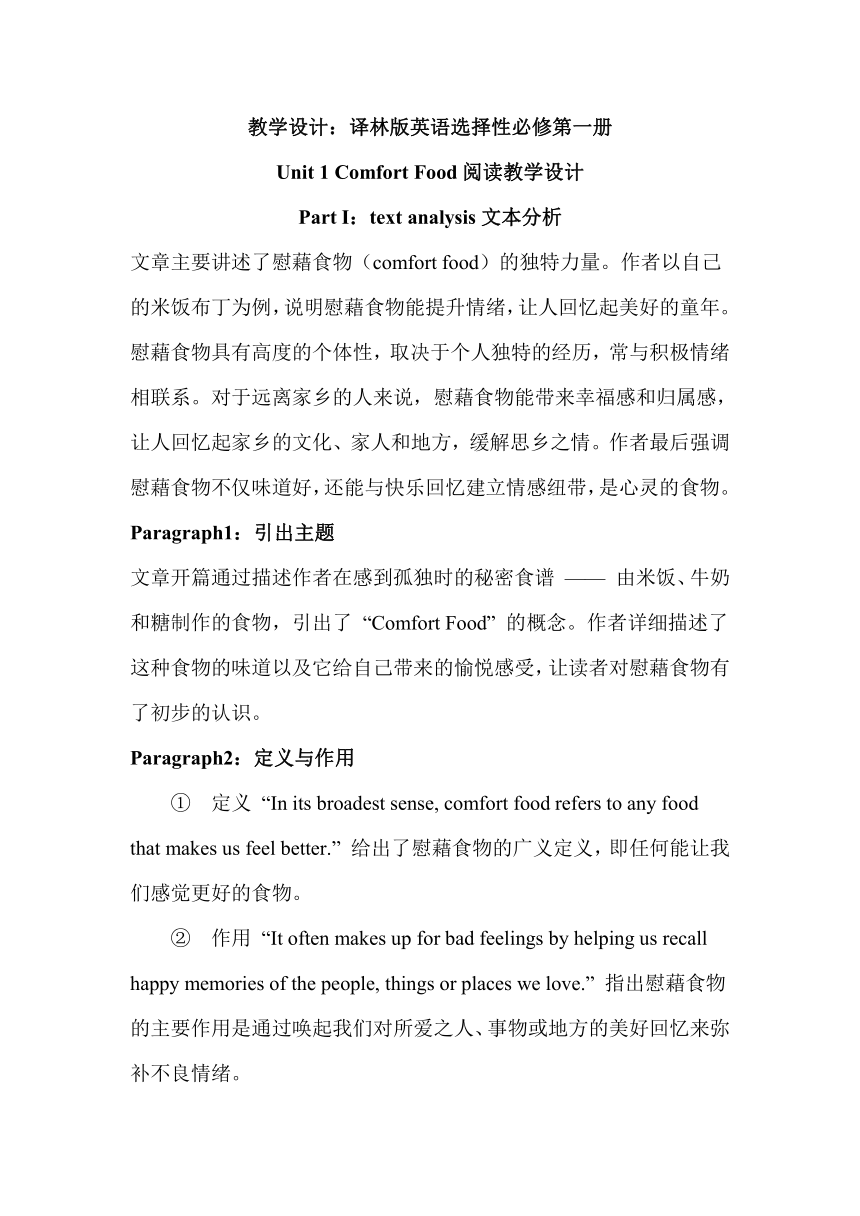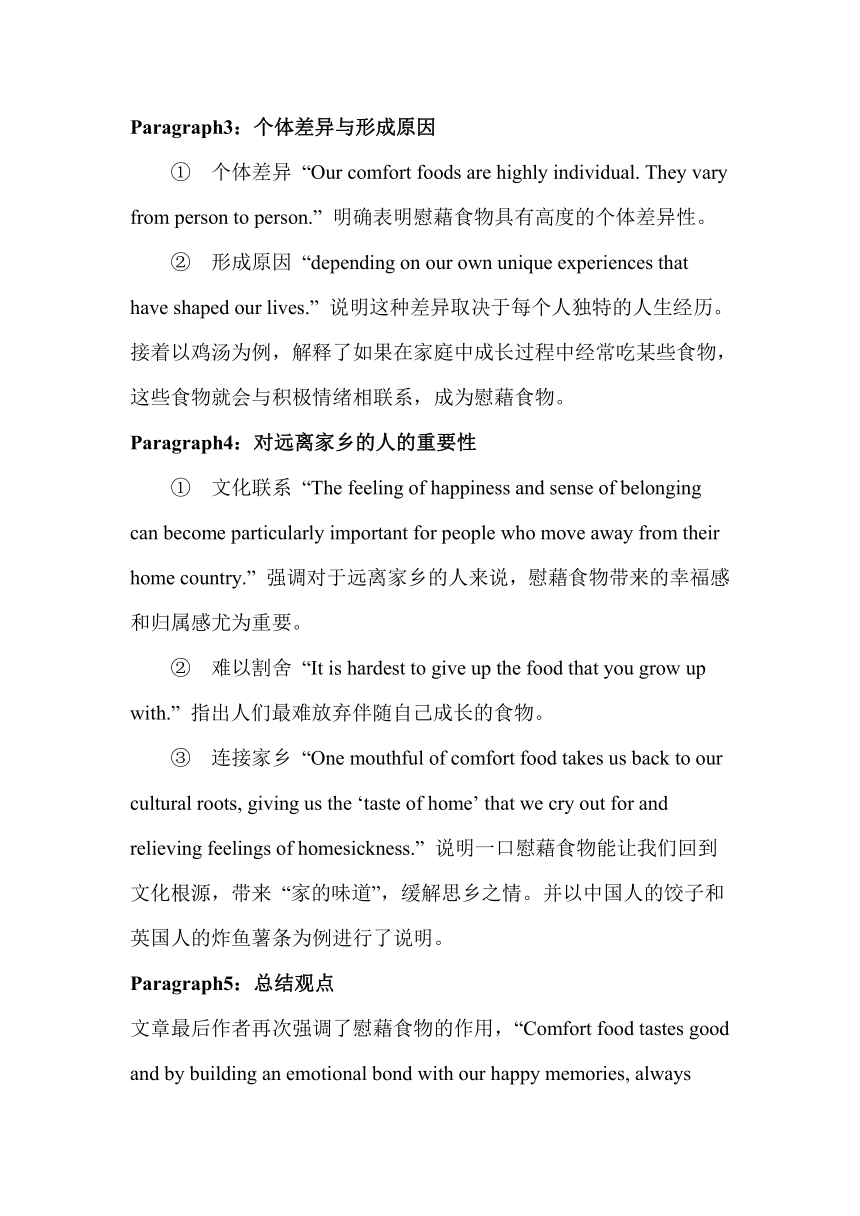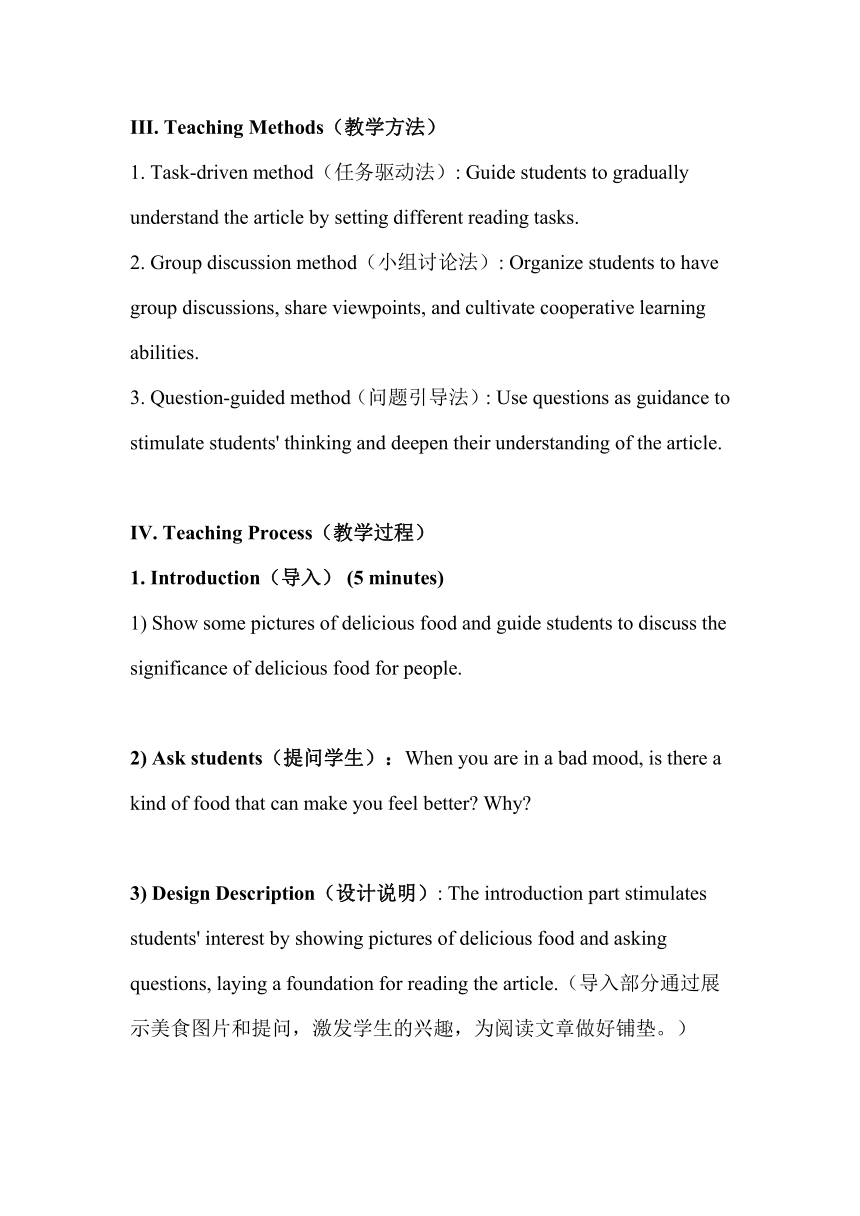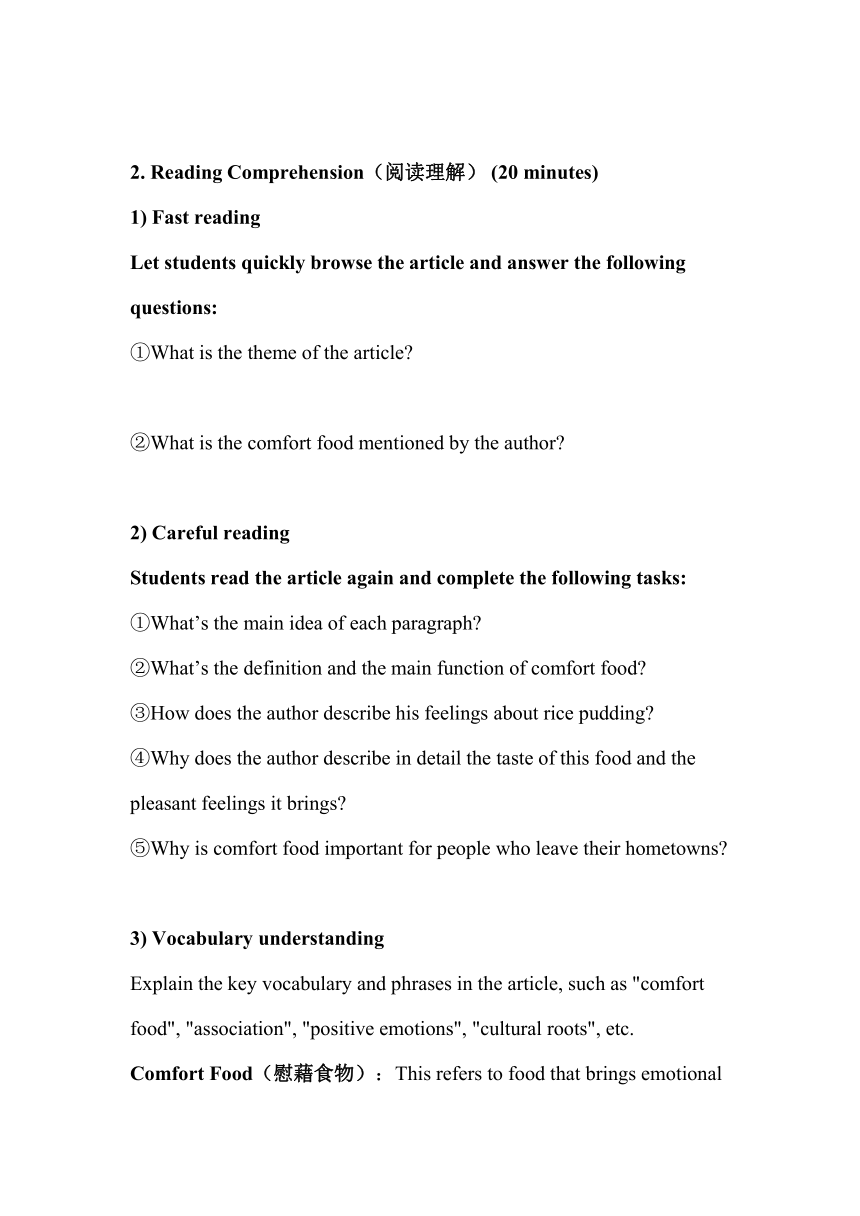牛津译林版(2019)选择性必修 第一册 Unit 1 Comfort Food Reading 教学设计
文档属性
| 名称 | 牛津译林版(2019)选择性必修 第一册 Unit 1 Comfort Food Reading 教学设计 |  | |
| 格式 | docx | ||
| 文件大小 | 21.9KB | ||
| 资源类型 | 教案 | ||
| 版本资源 | 牛津译林版(2019) | ||
| 科目 | 英语 | ||
| 更新时间 | 2024-09-13 17:12:51 | ||
图片预览





文档简介
教学设计:译林版英语选择性必修第一册
Unit 1 Comfort Food阅读教学设计
Part I:text analysis文本分析
文章主要讲述了慰藉食物(comfort food)的独特力量。作者以自己的米饭布丁为例,说明慰藉食物能提升情绪,让人回忆起美好的童年。慰藉食物具有高度的个体性,取决于个人独特的经历,常与积极情绪相联系。对于远离家乡的人来说,慰藉食物能带来幸福感和归属感,让人回忆起家乡的文化、家人和地方,缓解思乡之情。作者最后强调慰藉食物不仅味道好,还能与快乐回忆建立情感纽带,是心灵的食物。
Paragraph1:引出主题
文章开篇通过描述作者在感到孤独时的秘密食谱 —— 由米饭、牛奶和糖制作的食物,引出了 “Comfort Food” 的概念。作者详细描述了这种食物的味道以及它给自己带来的愉悦感受,让读者对慰藉食物有了初步的认识。
Paragraph2:定义与作用
① 定义 “In its broadest sense, comfort food refers to any food that makes us feel better.” 给出了慰藉食物的广义定义,即任何能让我们感觉更好的食物。
② 作用 “It often makes up for bad feelings by helping us recall happy memories of the people, things or places we love.” 指出慰藉食物的主要作用是通过唤起我们对所爱之人、事物或地方的美好回忆来弥补不良情绪。
Paragraph3:个体差异与形成原因
① 个体差异 “Our comfort foods are highly individual. They vary from person to person.” 明确表明慰藉食物具有高度的个体差异性。
② 形成原因 “depending on our own unique experiences that have shaped our lives.” 说明这种差异取决于每个人独特的人生经历。接着以鸡汤为例,解释了如果在家庭中成长过程中经常吃某些食物,这些食物就会与积极情绪相联系,成为慰藉食物。
Paragraph4:对远离家乡的人的重要性
① 文化联系 “The feeling of happiness and sense of belonging can become particularly important for people who move away from their home country.” 强调对于远离家乡的人来说,慰藉食物带来的幸福感和归属感尤为重要。
② 难以割舍 “It is hardest to give up the food that you grow up with.” 指出人们最难放弃伴随自己成长的食物。
③ 连接家乡 “One mouthful of comfort food takes us back to our cultural roots, giving us the ‘taste of home’ that we cry out for and relieving feelings of homesickness.” 说明一口慰藉食物能让我们回到文化根源,带来 “家的味道”,缓解思乡之情。并以中国人的饺子和英国人的炸鱼薯条为例进行了说明。
Paragraph5:总结观点
文章最后作者再次强调了慰藉食物的作用,“Comfort food tastes good and by building an emotional bond with our happy memories, always makes us feel good. It’s food for the soul.” 即慰藉食物不仅味道好,还能与我们的快乐回忆建立情感纽带,是心灵的食物。
Part2:Teaching plan
I. Teaching Objectives(教学目标)
After learning this article, students will be able to:
1. Understand the main content and details of the article.
2. Improve reading comprehension abilities, including accurately extracting key information and reasonably inferring the author's intention.
3. Enhance vocabulary understanding and application abilities.
4. Recognize the close connection between food and emotions.
5. Inspire love for hometown and traditional culture.
II. Teaching Key and Difficult Points(教学重难点)
1. Teaching Key Points(教学重点)
1) Understand the definition and function of comfort food.
2) Analyze the author's personal experience with comfort food in the article.
3) Master the key vocabulary and phrases in the article.
2. Teaching Difficult Points(教学难点)
1) Understand how food becomes an emotional bond and its importance to people.
2) Guide students to share their feelings about comfort food based on their own experiences.
III. Teaching Methods(教学方法)
1. Task-driven method(任务驱动法): Guide students to gradually understand the article by setting different reading tasks.
2. Group discussion method(小组讨论法): Organize students to have group discussions, share viewpoints, and cultivate cooperative learning abilities.
3. Question-guided method(问题引导法): Use questions as guidance to stimulate students' thinking and deepen their understanding of the article.
IV. Teaching Process(教学过程)
1. Introduction(导入) (5 minutes)
1) Show some pictures of delicious food and guide students to discuss the significance of delicious food for people.
2) Ask students(提问学生):When you are in a bad mood, is there a kind of food that can make you feel better Why
3) Design Description(设计说明): The introduction part stimulates students' interest by showing pictures of delicious food and asking questions, laying a foundation for reading the article.(导入部分通过展示美食图片和提问,激发学生的兴趣,为阅读文章做好铺垫。)
2. Reading Comprehension(阅读理解) (20 minutes)
1) Fast reading
Let students quickly browse the article and answer the following questions:
①What is the theme of the article
②What is the comfort food mentioned by the author
2) Careful reading
Students read the article again and complete the following tasks:
①What’s the main idea of each paragraph
②What’s the definition and the main function of comfort food
③How does the author describe his feelings about rice pudding
④Why does the author describe in detail the taste of this food and the pleasant feelings it brings
⑤Why is comfort food important for people who leave their hometowns
3) Vocabulary understanding
Explain the key vocabulary and phrases in the article, such as "comfort food", "association", "positive emotions", "cultural roots", etc.
Comfort Food(慰藉食物):This refers to food that brings emotional comfort and a sense of well-being. It is often food that people turn to when they are feeling down, stressed, or in need of a pick-me-up.(这是指能带来情感上的慰藉和幸福感的食物。通常是人们在情绪低落、压力大或需要振作时会选择的食物。)
Association(关联):An association is a connection or link between two or more things. In the context of the article, comfort food has associations with positive emotions, memories, and cultural roots.(“关联” 是指两个或多个事物之间的联系或连接。在本文中,慰藉食物与积极的情绪、回忆以及文化根源有关联。)
Positive Emotions(积极情绪):These are feelings that are pleasant and fort food can evoke positive emotions such as happiness, contentment, and relaxation.(这些是令人愉快和有益的感觉。慰藉食物可以唤起积极的情绪,如幸福、满足和放松。)
Cultural Roots(文化根源):This refers to the origins and traditions of a particular fort food often has deep cultural roots, representing the food traditions and values of a particular group or region.(这是指特定文化的起源和传统。慰藉食物通常有深厚的文化根源,代表着特定群体或地区的食物传统和价值观。)
Design Description(设计说明): The reading comprehension part uses a combination of fast reading and careful reading to help students gradually understand the main content and details of the article. The vocabulary understanding link helps students master the key vocabulary in the article and improve language application abilities.(阅读理解部分采用快速阅读和仔细阅读相结合的方式,帮助学生逐步理解文章的主要内容和细节。词汇理解环节有助于学生掌握文章中的重点词汇,提高语言运用能力。)
3. Group Discussion(小组讨论) (10 minutes)
1) Divide students into groups and discuss the following questions:
①Do you have your own comfort food What is it Why does it make you feel better
The answers vary from person to person. For example: For me, my comfort food is chocolate. When I eat chocolate, it releases endorphins in my brain, making me feel happy and relaxed. Also, it reminds me of happy times when I shared chocolates with my friends and family.(答案因人而异。例如:对我来说,我的慰藉食物是巧克力。当我吃巧克力时,它会在我的大脑中释放内啡肽,让我感到快乐和放松。此外,它还让我想起和朋友、家人一起分享巧克力的快乐时光。)
②How can food become an emotional bond
Food can become an emotional bond because it is often associated with specific people, events, or places. For example, a dish that your grandma used to make can bring back memories of her love and care. Sharing a meal with friends or family can create a sense of connection and belonging. Also, certain foods can evoke positive emotions and comfort us during difficult times.(食物可以成为情感纽带,因为它常常与特定的人、事件或地方联系在一起。例如,一道你奶奶曾经做过的菜可以唤起她的爱和关怀的回忆。与朋友或家人一起用餐可以创造一种联系感和归属感。此外,某些食物可以唤起积极的情绪,在困难时期给我们带来安慰。)
2) Each group selects a representative to speak and share the results of the group discussion.
Design Description(设计说明): The group discussion link allows students to share their feelings about comfort food based on their own experiences, cultivating students' cooperative learning and expression abilities. At the same time, by discussing the relationship between food and emotions, guide students to deeply think about the theme of the article.(小组讨论环节让学生结合自身经历分享对 comfort food 的感受,培养学生的合作学习能力和表达能力。同时,通过讨论食物与情感的关系,引导学生深入思考文章的主题。)
4. Summary and Expansion(总结与拓展)(5 minutes)
1) Summarize the main content and key vocabulary of the article.
2) Guide students to think:
In addition to food, what else can be a source of comfort Encourage students to think and explore after class.
① Music can be a great source of comfort. When we listen to our favorite tunes, it can soothe our emotions and relax our minds.(音乐可以是慰藉的来源。当我们听着最喜欢的曲调时,它可以舒缓我们的情绪并放松我们的心灵。)
② Another source could be spending time with loved ones. The warmth and support of family and friends can bring great comfort.(另一个来源可以是和所爱的人在一起。家人和朋友的温暖与支持能带来极大的慰藉。)
③ Reading a good book can also be a source of comfort. It allows us to escape into different worlds and gain new perspectives.(读一本好书也可以是慰藉的来源。它让我们能够逃进不同的世界并获得新的视角。)
④ Nature can be a source of comfort as well. Spending time in the outdoors, whether it's taking a walk in the park, sitting by the beach, or hiking in the mountains, can calm our minds and rejuvenate our spirits. The beauty and tranquility of nature can bring a sense of peace and comfort.(大自然也可以是慰藉的来源。花时间在户外,无论是在公园散步、坐在海边还是在山间徒步,都能让我们的心灵平静下来并使我们的精神恢复活力。大自然的美丽与宁静能带来一种平和与舒适的感觉。)
⑤ Finally, engaging in hobbies like painting, gardening, or sports can provide comfort by giving us a sense of accomplishment and enjoyment.(最后,从事像绘画、园艺或运动这样的爱好也可以提供慰藉,因为它们能给我们带来成就感和愉悦感。)
Design Description(设计说明): The summary and expansion part summarizes the article and consolidates students' learning results. At the same time, it raises extended questions to stimulate students' thinking and cultivate students' innovative thinking abilities.(总结与拓展部分对文章进行总结,巩固学生的学习成果。同时,提出拓展性问题,激发学生的思考,培养学生的创新思维能力。)
5.Homework: writing
以 My comfort food为题,写一篇80词的演讲稿。内容包括:
1.What is comfort food;
2.What's your comfort food and why
Unit 1 Comfort Food阅读教学设计
Part I:text analysis文本分析
文章主要讲述了慰藉食物(comfort food)的独特力量。作者以自己的米饭布丁为例,说明慰藉食物能提升情绪,让人回忆起美好的童年。慰藉食物具有高度的个体性,取决于个人独特的经历,常与积极情绪相联系。对于远离家乡的人来说,慰藉食物能带来幸福感和归属感,让人回忆起家乡的文化、家人和地方,缓解思乡之情。作者最后强调慰藉食物不仅味道好,还能与快乐回忆建立情感纽带,是心灵的食物。
Paragraph1:引出主题
文章开篇通过描述作者在感到孤独时的秘密食谱 —— 由米饭、牛奶和糖制作的食物,引出了 “Comfort Food” 的概念。作者详细描述了这种食物的味道以及它给自己带来的愉悦感受,让读者对慰藉食物有了初步的认识。
Paragraph2:定义与作用
① 定义 “In its broadest sense, comfort food refers to any food that makes us feel better.” 给出了慰藉食物的广义定义,即任何能让我们感觉更好的食物。
② 作用 “It often makes up for bad feelings by helping us recall happy memories of the people, things or places we love.” 指出慰藉食物的主要作用是通过唤起我们对所爱之人、事物或地方的美好回忆来弥补不良情绪。
Paragraph3:个体差异与形成原因
① 个体差异 “Our comfort foods are highly individual. They vary from person to person.” 明确表明慰藉食物具有高度的个体差异性。
② 形成原因 “depending on our own unique experiences that have shaped our lives.” 说明这种差异取决于每个人独特的人生经历。接着以鸡汤为例,解释了如果在家庭中成长过程中经常吃某些食物,这些食物就会与积极情绪相联系,成为慰藉食物。
Paragraph4:对远离家乡的人的重要性
① 文化联系 “The feeling of happiness and sense of belonging can become particularly important for people who move away from their home country.” 强调对于远离家乡的人来说,慰藉食物带来的幸福感和归属感尤为重要。
② 难以割舍 “It is hardest to give up the food that you grow up with.” 指出人们最难放弃伴随自己成长的食物。
③ 连接家乡 “One mouthful of comfort food takes us back to our cultural roots, giving us the ‘taste of home’ that we cry out for and relieving feelings of homesickness.” 说明一口慰藉食物能让我们回到文化根源,带来 “家的味道”,缓解思乡之情。并以中国人的饺子和英国人的炸鱼薯条为例进行了说明。
Paragraph5:总结观点
文章最后作者再次强调了慰藉食物的作用,“Comfort food tastes good and by building an emotional bond with our happy memories, always makes us feel good. It’s food for the soul.” 即慰藉食物不仅味道好,还能与我们的快乐回忆建立情感纽带,是心灵的食物。
Part2:Teaching plan
I. Teaching Objectives(教学目标)
After learning this article, students will be able to:
1. Understand the main content and details of the article.
2. Improve reading comprehension abilities, including accurately extracting key information and reasonably inferring the author's intention.
3. Enhance vocabulary understanding and application abilities.
4. Recognize the close connection between food and emotions.
5. Inspire love for hometown and traditional culture.
II. Teaching Key and Difficult Points(教学重难点)
1. Teaching Key Points(教学重点)
1) Understand the definition and function of comfort food.
2) Analyze the author's personal experience with comfort food in the article.
3) Master the key vocabulary and phrases in the article.
2. Teaching Difficult Points(教学难点)
1) Understand how food becomes an emotional bond and its importance to people.
2) Guide students to share their feelings about comfort food based on their own experiences.
III. Teaching Methods(教学方法)
1. Task-driven method(任务驱动法): Guide students to gradually understand the article by setting different reading tasks.
2. Group discussion method(小组讨论法): Organize students to have group discussions, share viewpoints, and cultivate cooperative learning abilities.
3. Question-guided method(问题引导法): Use questions as guidance to stimulate students' thinking and deepen their understanding of the article.
IV. Teaching Process(教学过程)
1. Introduction(导入) (5 minutes)
1) Show some pictures of delicious food and guide students to discuss the significance of delicious food for people.
2) Ask students(提问学生):When you are in a bad mood, is there a kind of food that can make you feel better Why
3) Design Description(设计说明): The introduction part stimulates students' interest by showing pictures of delicious food and asking questions, laying a foundation for reading the article.(导入部分通过展示美食图片和提问,激发学生的兴趣,为阅读文章做好铺垫。)
2. Reading Comprehension(阅读理解) (20 minutes)
1) Fast reading
Let students quickly browse the article and answer the following questions:
①What is the theme of the article
②What is the comfort food mentioned by the author
2) Careful reading
Students read the article again and complete the following tasks:
①What’s the main idea of each paragraph
②What’s the definition and the main function of comfort food
③How does the author describe his feelings about rice pudding
④Why does the author describe in detail the taste of this food and the pleasant feelings it brings
⑤Why is comfort food important for people who leave their hometowns
3) Vocabulary understanding
Explain the key vocabulary and phrases in the article, such as "comfort food", "association", "positive emotions", "cultural roots", etc.
Comfort Food(慰藉食物):This refers to food that brings emotional comfort and a sense of well-being. It is often food that people turn to when they are feeling down, stressed, or in need of a pick-me-up.(这是指能带来情感上的慰藉和幸福感的食物。通常是人们在情绪低落、压力大或需要振作时会选择的食物。)
Association(关联):An association is a connection or link between two or more things. In the context of the article, comfort food has associations with positive emotions, memories, and cultural roots.(“关联” 是指两个或多个事物之间的联系或连接。在本文中,慰藉食物与积极的情绪、回忆以及文化根源有关联。)
Positive Emotions(积极情绪):These are feelings that are pleasant and fort food can evoke positive emotions such as happiness, contentment, and relaxation.(这些是令人愉快和有益的感觉。慰藉食物可以唤起积极的情绪,如幸福、满足和放松。)
Cultural Roots(文化根源):This refers to the origins and traditions of a particular fort food often has deep cultural roots, representing the food traditions and values of a particular group or region.(这是指特定文化的起源和传统。慰藉食物通常有深厚的文化根源,代表着特定群体或地区的食物传统和价值观。)
Design Description(设计说明): The reading comprehension part uses a combination of fast reading and careful reading to help students gradually understand the main content and details of the article. The vocabulary understanding link helps students master the key vocabulary in the article and improve language application abilities.(阅读理解部分采用快速阅读和仔细阅读相结合的方式,帮助学生逐步理解文章的主要内容和细节。词汇理解环节有助于学生掌握文章中的重点词汇,提高语言运用能力。)
3. Group Discussion(小组讨论) (10 minutes)
1) Divide students into groups and discuss the following questions:
①Do you have your own comfort food What is it Why does it make you feel better
The answers vary from person to person. For example: For me, my comfort food is chocolate. When I eat chocolate, it releases endorphins in my brain, making me feel happy and relaxed. Also, it reminds me of happy times when I shared chocolates with my friends and family.(答案因人而异。例如:对我来说,我的慰藉食物是巧克力。当我吃巧克力时,它会在我的大脑中释放内啡肽,让我感到快乐和放松。此外,它还让我想起和朋友、家人一起分享巧克力的快乐时光。)
②How can food become an emotional bond
Food can become an emotional bond because it is often associated with specific people, events, or places. For example, a dish that your grandma used to make can bring back memories of her love and care. Sharing a meal with friends or family can create a sense of connection and belonging. Also, certain foods can evoke positive emotions and comfort us during difficult times.(食物可以成为情感纽带,因为它常常与特定的人、事件或地方联系在一起。例如,一道你奶奶曾经做过的菜可以唤起她的爱和关怀的回忆。与朋友或家人一起用餐可以创造一种联系感和归属感。此外,某些食物可以唤起积极的情绪,在困难时期给我们带来安慰。)
2) Each group selects a representative to speak and share the results of the group discussion.
Design Description(设计说明): The group discussion link allows students to share their feelings about comfort food based on their own experiences, cultivating students' cooperative learning and expression abilities. At the same time, by discussing the relationship between food and emotions, guide students to deeply think about the theme of the article.(小组讨论环节让学生结合自身经历分享对 comfort food 的感受,培养学生的合作学习能力和表达能力。同时,通过讨论食物与情感的关系,引导学生深入思考文章的主题。)
4. Summary and Expansion(总结与拓展)(5 minutes)
1) Summarize the main content and key vocabulary of the article.
2) Guide students to think:
In addition to food, what else can be a source of comfort Encourage students to think and explore after class.
① Music can be a great source of comfort. When we listen to our favorite tunes, it can soothe our emotions and relax our minds.(音乐可以是慰藉的来源。当我们听着最喜欢的曲调时,它可以舒缓我们的情绪并放松我们的心灵。)
② Another source could be spending time with loved ones. The warmth and support of family and friends can bring great comfort.(另一个来源可以是和所爱的人在一起。家人和朋友的温暖与支持能带来极大的慰藉。)
③ Reading a good book can also be a source of comfort. It allows us to escape into different worlds and gain new perspectives.(读一本好书也可以是慰藉的来源。它让我们能够逃进不同的世界并获得新的视角。)
④ Nature can be a source of comfort as well. Spending time in the outdoors, whether it's taking a walk in the park, sitting by the beach, or hiking in the mountains, can calm our minds and rejuvenate our spirits. The beauty and tranquility of nature can bring a sense of peace and comfort.(大自然也可以是慰藉的来源。花时间在户外,无论是在公园散步、坐在海边还是在山间徒步,都能让我们的心灵平静下来并使我们的精神恢复活力。大自然的美丽与宁静能带来一种平和与舒适的感觉。)
⑤ Finally, engaging in hobbies like painting, gardening, or sports can provide comfort by giving us a sense of accomplishment and enjoyment.(最后,从事像绘画、园艺或运动这样的爱好也可以提供慰藉,因为它们能给我们带来成就感和愉悦感。)
Design Description(设计说明): The summary and expansion part summarizes the article and consolidates students' learning results. At the same time, it raises extended questions to stimulate students' thinking and cultivate students' innovative thinking abilities.(总结与拓展部分对文章进行总结,巩固学生的学习成果。同时,提出拓展性问题,激发学生的思考,培养学生的创新思维能力。)
5.Homework: writing
以 My comfort food为题,写一篇80词的演讲稿。内容包括:
1.What is comfort food;
2.What's your comfort food and why
同课章节目录
- Unit 1 Food matters
- Welcome to the unit
- Reading
- Grammar and usage
- Integrated skills
- Extended reading
- Project
- Unit 2 The Universal Language
- Welcome to the unit
- Reading
- Grammar and usage
- Integrated skills
- Extended reading
- Project
- Unit 3 The art of painting
- Welcome to the unit
- Reading
- Grammar and usage
- Integrated skills
- Extended reading
- Project
- Unit 4 Exploring poetry
- Welcome to the unit
- Reading
- Grammar and usage
- Integrated skills
- Extended reading
- Project
